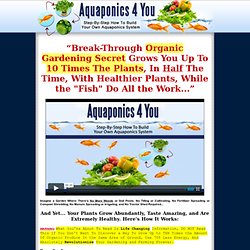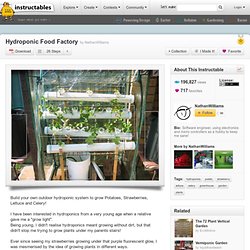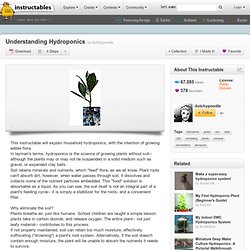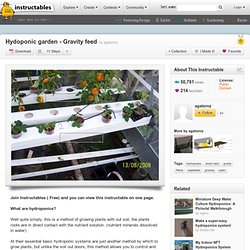

11 Inspiring Vertical Gardens. 11 Inspiring Vertical Gardens. DIY Green Walls: Vertical Gardening. Barrel-Ponics Instructions. Mediamaker2000. Vertical Gardens, Hanging Wall Garden Planters for Urban Gardening. ENEA News - Skyland, the vertical farm made in Italy. Aeroponic Tower Garden Vertical Garden. Vertical farms solve land problem. Garden Tower Project - The Garden Tower Project. Grow-Anywhere Air-Foods Facility and Air-Food Brand elite culinary foods. How to build My 50 Dollar Greenhouse.
First off – you really can build this thing very cheaply, but to do so you have to recycle, freecycle, and scrounge.

If you just go out and buy new everything it will probably cost over $200 – still not bad all in all.This Article is featured in Jan 2010 issue of Birds and Blooms Magazine! Want to find out if this thing works before you read all this? Read 6 months in the Greenhouse first.Want to see what happens when a few inches of wet snow accumulates on this? Collapse! Building the Greenhouse Doors is addressed in a separate article – isn’t this enough for one weekend? My $50 Greenhouse Welcome Stumbleupon Gardeners! Materials list Construction Steps Hind Sight – What I would do differently The planning is over and construction on my hoop house greenhouse has begun.
After some research I’ve decided to build the structure of the hoop house out of 20 ft. joints of three quarter inch PVC plumbing pipe. Aquaponics 4 You - Step-By-Step How To Build Your Own Aquaponics System. “Break-Through Organic Gardening Secret Grows You Up To 10 Times The Plants, In Half The Time, With Healthier Plants, While the "Fish" Do All the Work...”

Imagine a Garden Where There's No More Weeds or Soil Pests, No Tilling or Cultivating, No Fertilizer Spreading or Compost Shredding, No Manure Spreading or Irrigating, and No Tractor Shed Required... And Yet... Your Plants Grow Abundantly, Taste Amazing, and Are Extremely Healthy. Here's How It Works: WARNING: What You're About To Read Is Life Changing Information, DO NOT Read This If You Don't Want To Discover a Way To Grow Up to TEN Times the Amount Of Organic Produce In the Same Area of Ground, Use 70% Less Energy, And Absolutely Revolutionize Your Gardening and Farming Forever. Dear Gardener, Imagine you knew a secret about growing plants in a break-through new way... to the outside world your organic garden or farm would seem almost "magic", Why?
This one family in Hawaii spends less than 1 hour per day. 1. Simple Ebb and Flow Hydroponic System. This instructable will show you how to build a simple ebb and flow hydroponic system.

Out of the many different designs I have tried in the past, the ebb and flow has worked the best for me. I have successfully grown smaller plants like lettuce and spinach as well as larger plants like zucchini and tomatoes with this system. Sketchup ModelTo make this design easier to understand, I have drawn up a Sketchup model and uploaded it to the 3D Warehouse. Hydroponic Food Factory. Hydroponics is not only an enjoyable hobby, it is also a green one.

Hydroponics use as little as 10% of the water needed for plants grown in dirt , and results in higher yields due to the plants always having the necessary nutrients available to them when they need it. Being a closed system, it also means that fertiliser is kept out of the water table, which is great for the environment. An added benefit is that there is a less chance for weeds and dirt bound insects to attack your plants, so there is less of a need for chemical poisons. Going furtherKeeping with the green spirit, this instructable uses recycled materials where possible, and uses a low power pump, to keep electricity use low. From using old PVC pipes, an old wooden baby's crib and other miscellaneous junk, not only is the cost kept down, but so is the waste.
When it comes to lights, it is hard to beat the Sun! How to plant seedlings in a hydroponics system. Phase 1 of Hydroponic Planter: Parts. DIY How to Make an Aeroponics 5 Gallon Bucket Hydroponics System. Small NFT Hydroponics System. Understanding Hydroponics. This instructable will explain household hydroponics, with the intention of growing edible flora.

In layman's terms, hydroponics is the science of growing plants without soil-- although the plants may or may not be suspended in a solid medium such as gravel, or expanded clay balls. Soil retains minerals and nutrients, which "feed" flora, as we all know. Plant roots can't absorb dirt, however; when water passes through soil, it dissolves and collects some of the nutrient particles embedded. This "food" solution is absorbable as a liquid. As you can see, the soil itself is not an integral part of a plant's feeding cycle-- it is simply a stabilizer for the roots, and a convenient filter.
Why eliminate the soil? Growing your own food can be a rewarding experience. That being said, there may be more efficient systems out there for the home grower. Hydoponic garden - Gravity feed. This instructable defines a system of hydroponics that is gravity feed, and provided you keep the nutrient tanks full, you only need to monitor plant health, occasionally maintain the system and chomp the end product.

It is based in a small glass house, but has been run successfully inside on a window sill and in a conservatory also. All references to "fig.... " refer to the individual photos on below each page(each is labelled in the yellow squares) In order for a plant to grow ( just like us..) it has 5 basic needs;a.) Water supply (we supply)b.) Food supply ( dissolved nutrient solution)c) Light for photosynthesis ( Mr sun)d) Temperature management (seasons + extension being in glass house)e) Gas exchange ( Mrs nature)
My first hydroponic set. Vertical Gardens Permaculture Courses. By Frank Gapinski.

Types of Hydroponic Systems # Their are six basic types of hydroponic systems and there are hundreds of variations (and combinations) of these hydroponic systems, but all hydroponic systems are based on these six system types.

By understanding what makes these systems work you can understand how all variations of hydroponic systems work. These Hydroponic systems are fairly simple in concept, and if you understand how the systems work, building your own Hydroponic system wont be hard and can even be fun. Vertical Gardening with AeroFalls- Macrofalls II. Soil-less sky farming: rooftop hydroponics on NYC restaurant. Greenhouse update 2. Update on our aquaponic greenhouse construction.
Workshop Hydroponics Instructables. These Glowing Indoor Garden Boxes are the Future of Urban Agriculture. HHH Kit: Bring Healthy Food Into Your Community & Help Fight Global Hunger. Bring Healthy Food Into Your Community & Help Fight Global Hunger!!!

Bring healthy fish, shrimp, and organic fuits and veggies into your community and home! The Healthy Home Harvest Kit serves as an instructional resource for anyone looking for a no-details-spaired, step-by-step guide to building, operating, and maintaining an aquaponics system scaled to suit your needs. The Healthy Home Harvest Kit will include four scalable aquaponics systems of different sizes. The smallest of the four sizes will be perfect for school project experiments with a simple design and small footprint.
The next three aquaponics system designs will increase proportionally in size, up to an aquaponics system with production capabilities of approximately 200 pounds per month (2,400 pounds per year). Www.backyardaquaponics.com/guide-to-aquaponics/what-is-aquaponics/ Aquaponics is essentially the combination of Aquaculture and Hydroponics.

Both aquaculture and hydroponics have some down sides, hydroponics requires expensive nutrients to feed the plants, and also requires periodic flushing of the systems which can lead to waste disposal issues. Re-circulating aquaculture needs to have excess nutrients removed from the system, normally this means that a percentage of the water is removed, generally on a daily basis. This nutrient rich water then needs to be disposed of and replaced with clean fresh water. While re-circulating aquaculture and hydroponics are both very efficient methods of producing fish and vegetables, when we look at combining the two, these negative aspects are turned into positives.